Introduction to Research and Organizing
If you are unfamiliar with how decisions relating to property are handled in New York City, trying to determine how to protect a property in your neighborhood can be confusing and daunting. This site is here to help!
We’ve divided this page into two parts - “Researching a Property” and “How to Organize.”
Research is the first step, because knowing what the current status of the property is can help you figure out what leverage the community has to influence what happens. Maybe an owner is doing something they shouldn't be doing. Maybe they're not doing something they should be doing. Maybe they need permission from the government to do what they want to do - which gives the community leverage to negotiate for other stuff the community wants, benefits that could go in a legally binding contract. Maybe there's a public process that will allow community members a chance to testify. Once you have this information, you’re in a better position to organize, which is where the “How to Organize” section comes in. You can also learn about what the government needs to do before approving certain land use changes at Public Review Processes.
NYCommons primarily focuses on publicly-owned assets, so most of the information on this site relates to those assets. But many of the same research questions and organizing strategies apply no matter who owns the property, so we encourage you to review these resources whatever situation you’re facing in your neighborhood.
What follows is not a comprehensive discussion of land use issues in New York City. Rather, we hope that this series of questions will serve as a useful introduction to the types of issues that come up in land use determinations and how to find relevant resources and information that can help your neighborhood or group develop an effective strategy.
Researching a Property
The very first step is to understand who owns the property you are studying.
Who owns it?
The very first step is to understand who owns the property in question.
When you search the NYCommons map, you will have a blue dot pop up at the location you searched. Public properties in the NYCommons dataset will appear on the map around or under the dot. As of July 2018, these are:
- City-owned waterfront properties (including eight publicly owned waterfront properties where development is pending)
- Post offices - both United States Postal Service (USPS) Owned Post Offices, and USPS Post Offices that are operated out of privately owned buildings under lease arrangements which place them at risk of closing (you can see these 42 mapped here)
- All of NYC’s parks
- NYC Parks Department buildings that are not accessible to the public (you can see the 39 buildings mapped here)
- Publicly owned vacant lots and community gardens
- Libraries (including three where development is pending)
- NYCHA campuses, including 107 that are planned for disposition to private entities (see a map of them here)
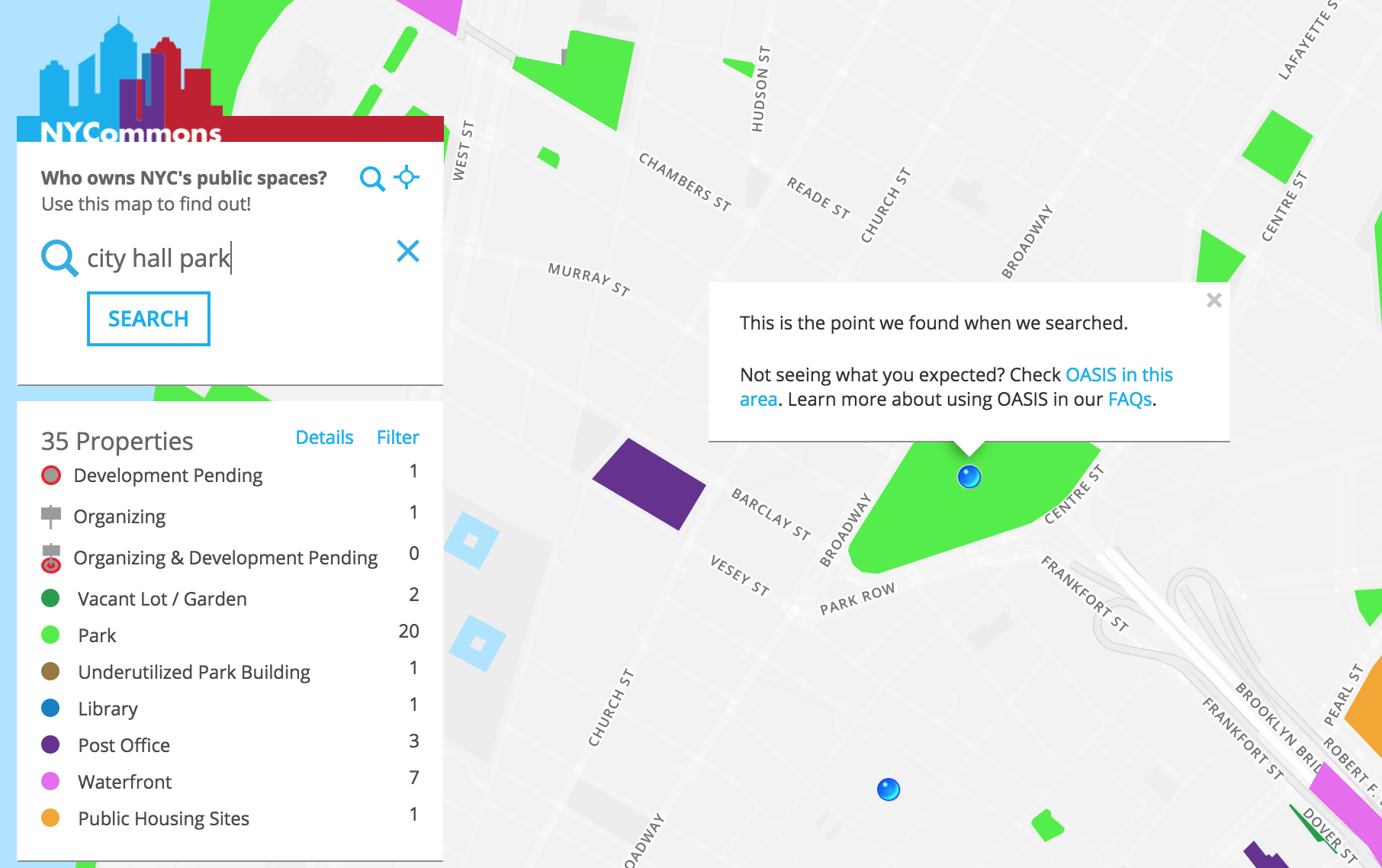
To get information about each of these properties, click on the shape to see its information, then click on LEARN MORE. A whole page of information about the property will open. Here is City Hall Park.
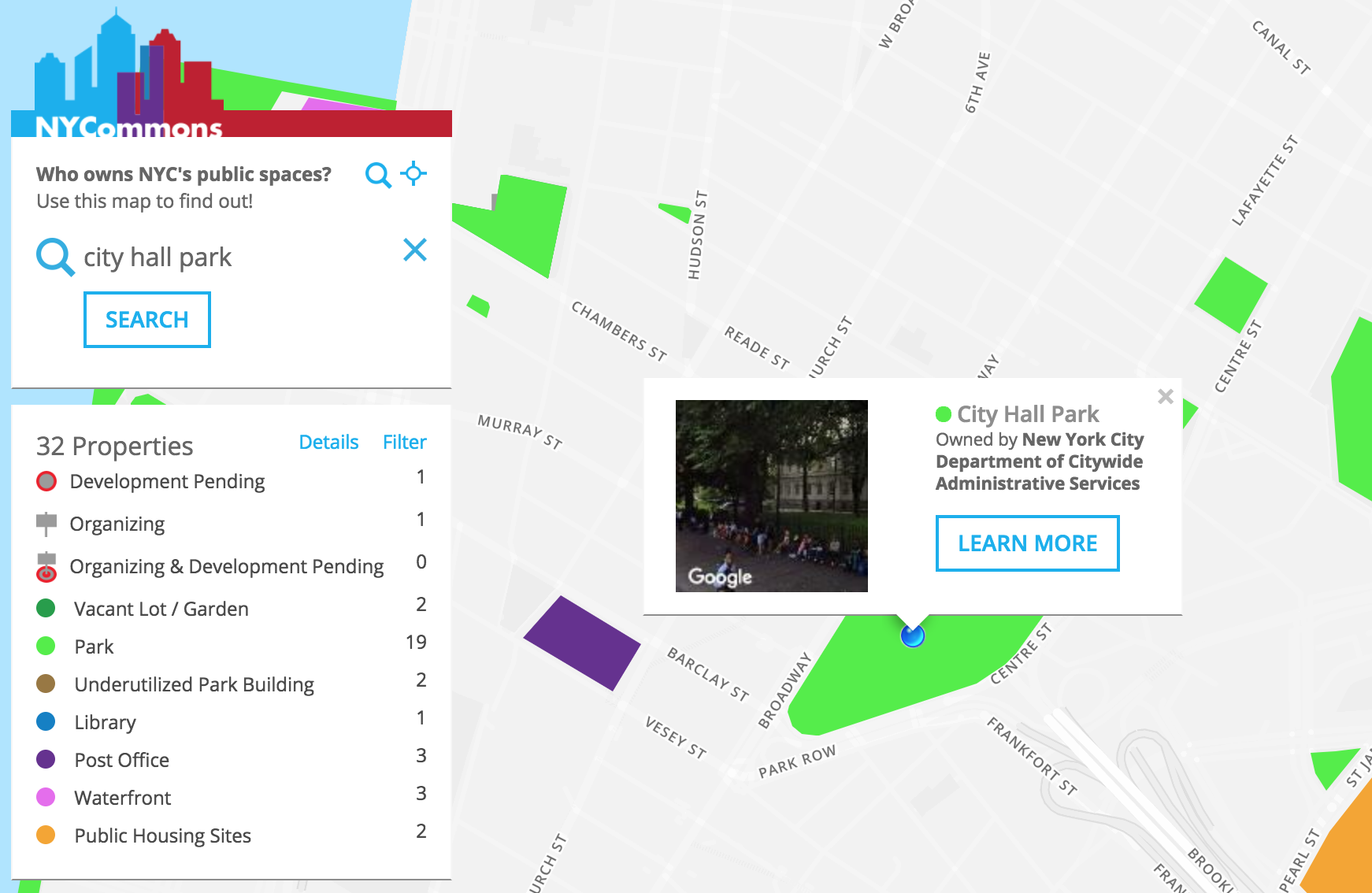
If your blue dot lands away from any shapes, that tells you that your property is not in the NYCommons database. It may be public or private. Follow the link to OASIS from the pop up box that appears to get more information. You can also find basic information about other public properties at the Department of City Planning NYC Facilities Explorer (last updated March 2018). This tool shows the properties that City agencies use for their programs.
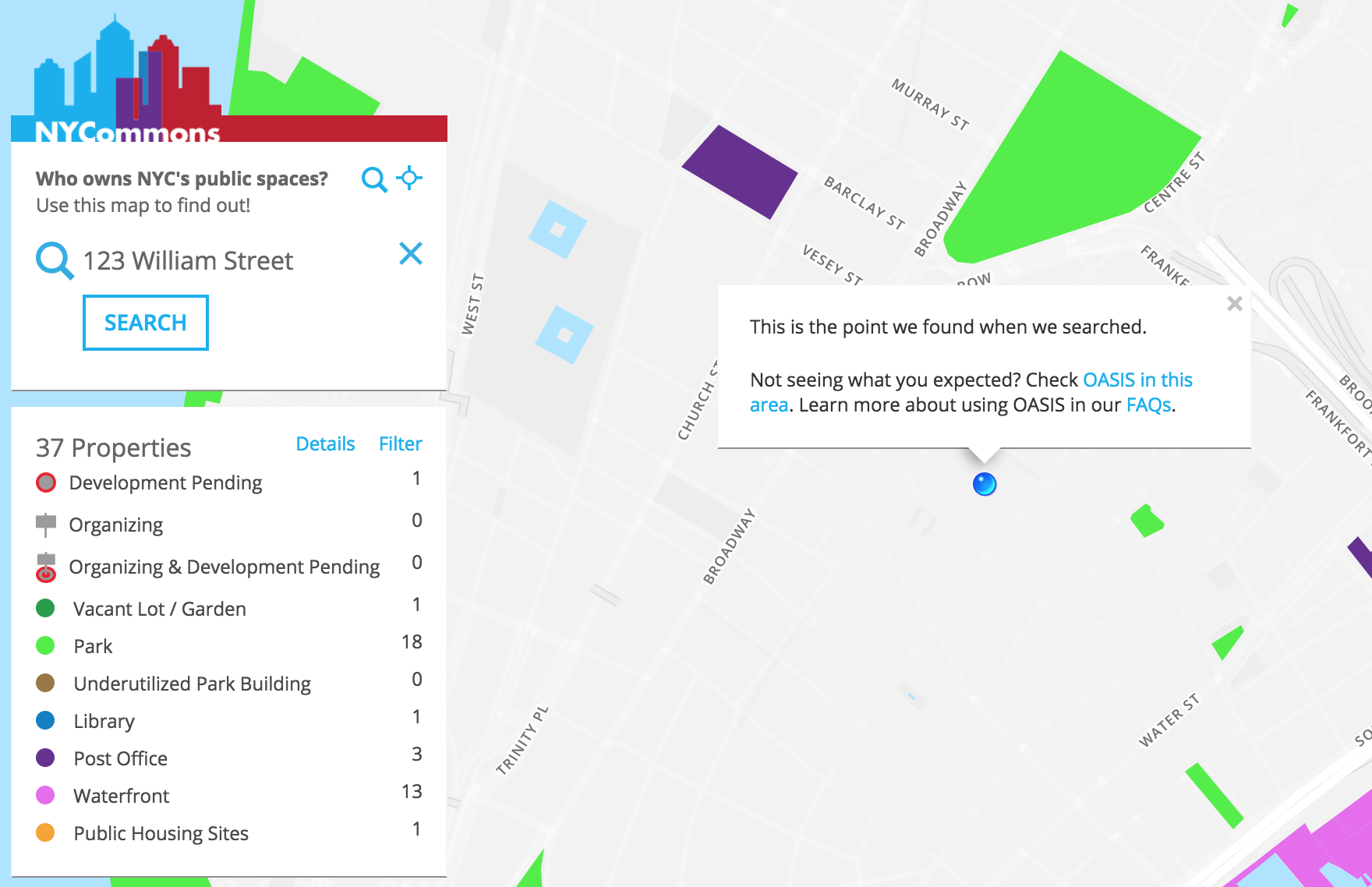
OASIS will show you the blocks and lots in the area. Vacant lots will appear brown in the view that opens.
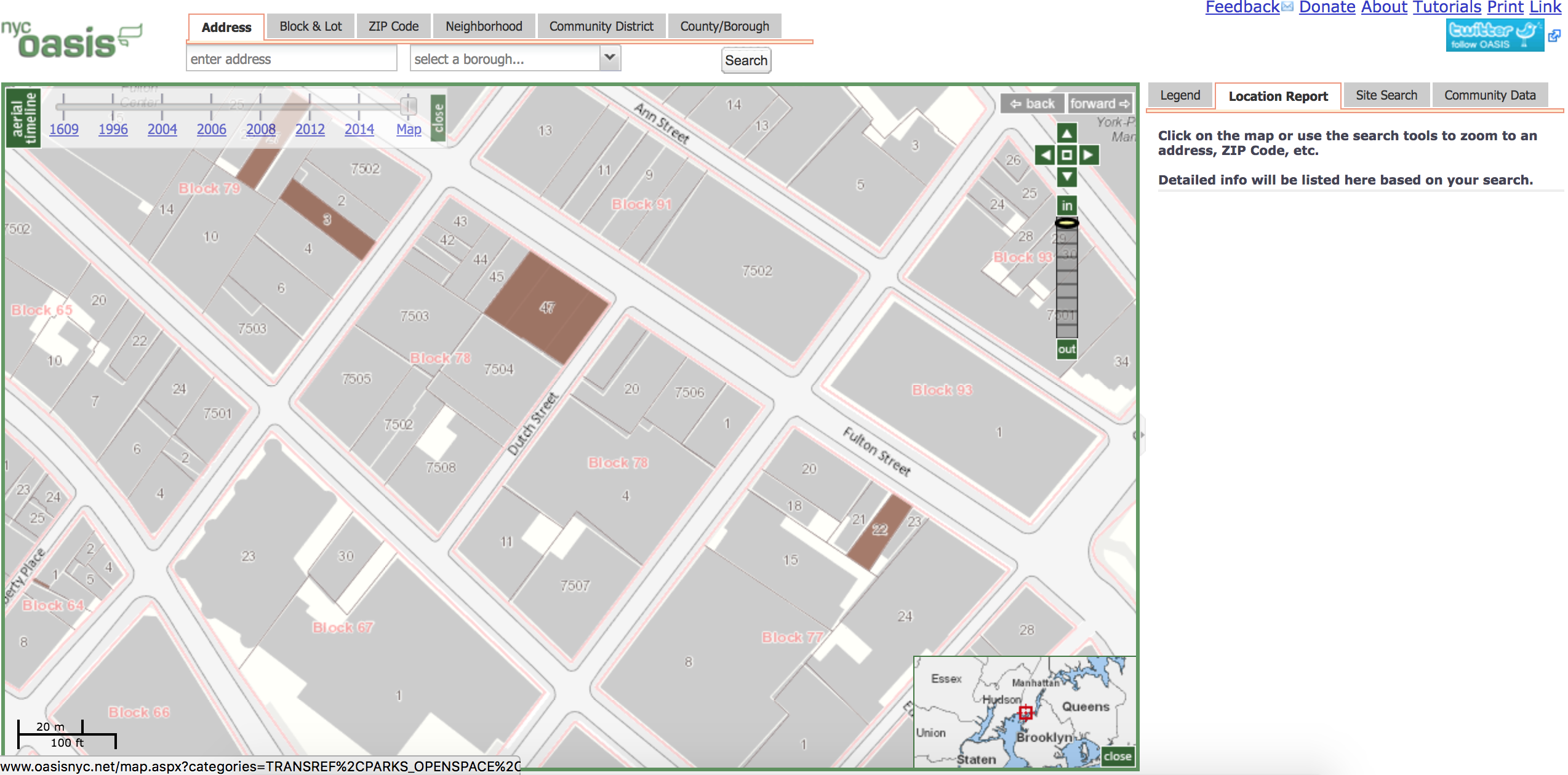
Select your property on the map and pay attention to the location report on the right hand side. Basic information will appear there, as well as links to the agency records for the property under MORE INFO. There is a lot to explore, but if you are trying to figure out who owns the property the most important links are to “Property Transaction Records” and the “NYC Department of Finance Assessment Roll.”
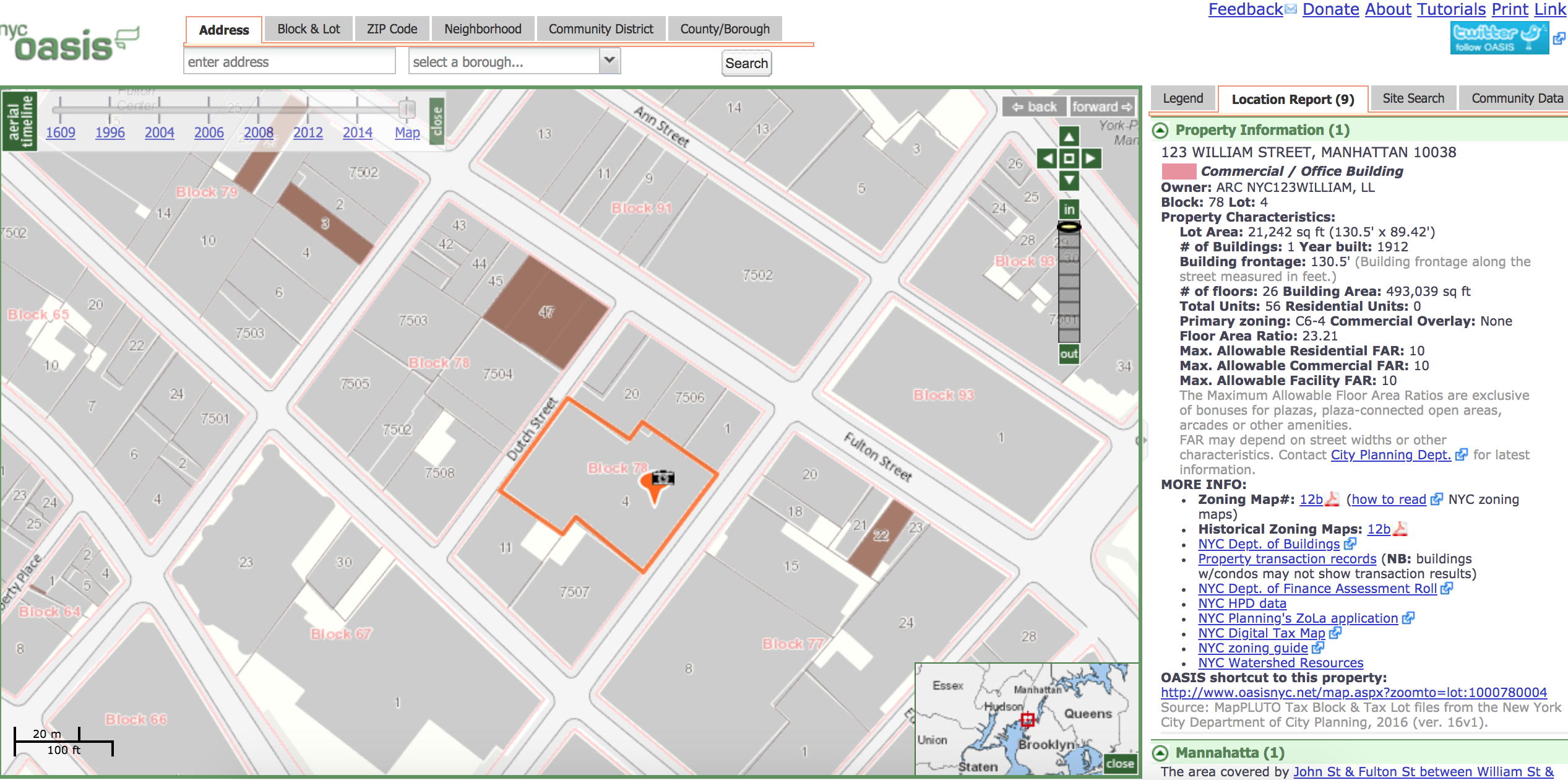
Clicking on “Property Transaction Records” will take you to the file for this specific property in the Automated City Register Information System (ACRIS), where all records for Manhattan, Brooklyn, Queens and Bronx properties are recorded. Finding the most recent recorded DEED and clicking on IMG to look at it will tell you who the current owner is. You might need to click past a few screens of entries before you find it. For help using ACRIS, contact the ACRIS Help Desk: acrishelp@finance.nyc.gov or 212-487-6300.
Note that most Staten Island property records are at a different location: the Richmond County Clerk. You will need to go there directly, but OASIS will help you figure out the Borough Block and Lot (BBL) numbers of the property.
Clicking on the “NYC Department of Finance Assessment Roll” will show you the tax bills for this specific property. You can look at those to find the owner’s current mailing address. The bills will also show any exemptions and registered rent stabilized apartment units. You can also look up any property with the BBL on the Department of Finance website.
If the owner is a corporation, you can also look them up in OpenCorporates. You can link to State Divisions of Corporations see whether the corporation is currently active or dissolved; you can also see what address the corporation has on file as the place the State can contact it.
Ownership isn’t the whole picture for public assets.
For public properties owned by the City of New York, the State of New York or the Federal Government, it is equally important to know what agency has been assigned jurisdiction and control over the maintenance, use and disposition of the property. You will see this information under “Official Owner” on the page for each property. You can use the Freedom of Information Law to request an agency's documents about the particular property. The Department of Citywide Administrative Services (DCAS) can transfer most City-owned properties between agencies without public review. These transfers can happen when an agency or the Mayor requests them. Transfers of parks have to follow special state law "alientation" rules, but all the other transfers can be done freely. If the transfer is being done to facilitate a development project, other public review processes might apply.
Certain buildings, structures, and neighborhoods that have special historic or cultural significance for the community are registered as a local landmark, historic district, or “historic place” by the City or State. Properties with these designations may have special protections that regulate how the building, site or historic district may be changed, or require public input before the property is sold. Many of the individual property pages on NYCommons include information about whether a place is landmarked - for example, the Brooklyn Public Library Grand Army Plaza Branch. You can also check for City Landmarks designations or the State and National Registers.
Many publicly owned properties became owned by the government due to the creation and passage of Urban Renewal Plans that allowed the City or State to force private owners to sell to fulfill "public purpose." Some of these properties have restrictions placed on them via the Plans. You will see these linked on the property pages, too. You can also find out more about Organizing in an Urban Renewal Area.
How to Organize
You might be deciding to start organizing because a public asset is being re-purposed, or sold, or ignored. You can read about some other groups that have done that in the NYCommons Case Studies. For example, a building used to be a public recreation center, now it’s no longer open to the public; or it was a school or post office, but now it’s empty; or something is proposed to be built on what used to be an open lot. Maybe plans have been announced to sell the property. The first step in getting ready to change the outcome is to find your people:
Existing community-based organizations are a great place to start since they and their members are already invested and involved in the community. Tenants’ rights groups, block associations, and local neighborhood institutions are all good places to connect. Here are some of the many organizing groups around the City you might want to connect with.
Your neighbors are natural allies. If you feel connected to a public place that’s under threat, chances are your neighbors might, too! Try to plug into existing neighborhood meetings, or if you don’t know of any, call a public meeting to find folks nearby who share your concerns.
The Community Board is often the first in the neighborhood to know about important land use issues. Figure out how to get in touch. The property page on NYCommons will tell you which Community Board to contact for each property in the database.
Elected officials including your local Council Member, your Borough President, your local Member of Congress, State Senator, or Assembly representative may be able to help you advocate for a community-oriented plan for the site in question. Council Members and the Community Board are directly involved in many NYC land use decisions. For each property on NYCommons, the Council Member and Community Board for that specific property is listed. Want to look up another property? Check here: http://www.mygovnyc.org/.
Here are some routes you might want to take for your organizing campaign:
- Protect Manufacturing Businesses & Jobs
- Organizing in An Urban Renewal Area
- Figure Out What Is Already Allowed to be Built
- Activate NYC Parks Buildings and the Parks Around Them
- Transform a Vacant Lot Into a Community Garden
- Get a Precious Place Landmarked
- Fight for Your Waterfront
- Get NYC Public Money for Your Project
- Protect a Designated NYC Landmark
- Find Out If Other Stewards Are Active
- Clean Up Environmental Hazards
- Find Out the History of the Property
